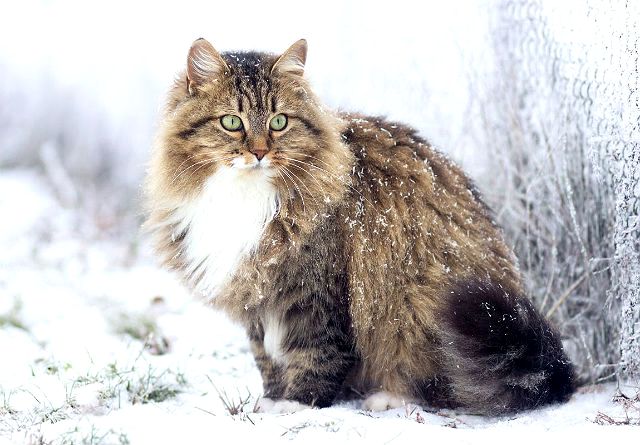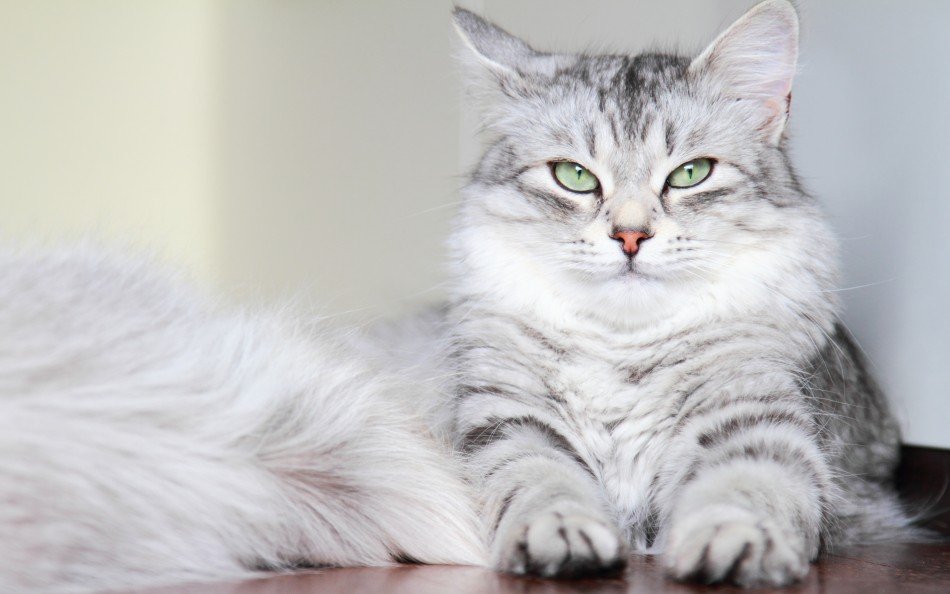A hypoallergenic cat
The Siberian cat has a rather exceptional characteristic in that it is naturally hypoallergenic, meaning that the risk of allergy is low.
Be careful not to confuse hypoallergenic and hypoallergenic. The former means that the risk of allergy is very low and the latter that the risk of allergy is non-existent.
So it's important to understand that even with a so-called "hypoallergenic" cat, the risk of developing an allergy is not zero, but it is low.
The Fel-d1 allergen
The vast majority of cat allergies are caused by a small, stable glycoprotein called Fel d 1.
Plant and animal allergens are listed in order of discovery. Each allergen found in a species is given a number when it is identified. Fel d 1 is therefore the first allergen discovered in domestic cats - feline domesticus allergen number 1. To date, there are 13!
Fel-d1 is produced by the lacrimal, salivary, sebaceous and perianal glands. During grooming, Fel-d1 of the saliva becomes airborne. The allergen from the skin glands remains in the fur and is then transferred to clothes, carpets and upholstery... Litter trays contain the greatest quantity of allergens.
So it's this famous protein, which is very low in Siberian cats, that makes them hypoallergenic.

Reduce Fel d 1

Does long hair affect Fel d 1 rates?
The length of the hair has no effect on the quantities of allergens produced, since it is only indirectly, through saliva, that the allergens are found on the hair. This is why hairless cats are not hypoallergenic, unlike Siberians.
Does the colour of the dress have any influence?
There is no evidence that dark or light coats have any effect on Fel d1, with the exception of silver and smoke. Over 400 Siberians have been tested for Fel d1 levels, and silver/smoke (it's actually the same gene) has always shown higher allergen levels. The reason for this is unknown, but it has been proposed that the silver gene may be carried on the same chromosome as Fel d1. A few low-allergen Siberian silvers have been reported, but not enough to be statistically valid. Allergic adopters are therefore advised to look for colours other than these.
Does neutering affect the production of feline allergens?
Several studies have shown that sterilisation significantly reduces Fel-d1 levels in males, but not in females. The allergen is hormonally controlled and unspayed males produce higher levels. After castration, allergen levels fall sharply to the same level as in females.

What about other allergens?
There are no simple answers to cat allergies, nor to cross-reactions between species. In 2005, thirteen cat allergen sera were isolated. One allergen may cause allergic reactions in one person but not in another, and most people allergic to cats are allergic to more than one feline allergen. It has been shown that Siberians have reduced levels of the Fel d 1 allergen, but have normal amounts of other allergens.
Approximately 80% of people who have allergies to horses / rabbits / rodents or who have food allergies to pork / egg white will react to the low allergen Siberian Fel d1. We have seen albumin reactions vary from mild to quite severe. These are mainly allergies to albumin and lipocalin.
Serum albumin (Fel d2)
Serum albumin accounts for around 30% of cross-reactions between cats and dogs, pork or egg white. Allergies to serum albumin can be quite serious.
Lipocalin (Fel d4) La
Lipocalin is a respiratory allergen and frequently causes asthma. Approximately 25% of people allergic to horses/rabbits also react to Fel d 4, a feline lipocalin. Studies have shown that intact male mice produce 500 to 1000 times more lipocalin than female mice. Although no studies have been carried out on cats, we have found that sterilisation / neutering helps to combat lipocalin allergies.
What precautions should be taken to limit the risk of allergies?

Does a bath reduce allergens?
Yes, the shampoo eliminates the allergens present in the fur. The cat will still produce the Fel d 1 allergen, but the amount in the air will be much lower. On average, weekly cat bathing reduces total levels of airborne allergens by 45% or more.
What about grooming?
Brushing your cat will release allergens into the air, which isn't exactly ideal. A simple solution is to dampen the hair before grooming.
And the litter tray?
Litter trays tend to cause the biggest asthma problems. Change the litter frequently, as Fel-d1 and other allergens are found in urine and faeces. Place the litter tray in the garage or in a room that can be ventilated to the outside. Cats can get dust on their coats from litter that is too dusty. Dust-free litter such as wood pellets is a good solution.
What about furniture?
Place washable throws where your cats like to sleep. Include the sofa and chairs as well as climbing stations and cat beds. Wash them regularly at 60° to deactivate allergens.
Housekeeping to reduce allergies .
Frequent vacuuming will significantly reduce allergen levels. Don't forget to clean upholstered furniture at the same time. Ventilate the house after vacuuming. Clean hard floors and wipe down hard surfaces to remove dust build-up. Replace carpets in bedrooms with hard washable flooring to reduce allergen levels.
Can the kitten sleep in my bedroom?
People with few allergies may allow their Siberian in the bedroom. But theeople with more severe allergies need a clean, allergen-free room in which to sleep. Do not leave the kitten in the bedrooms of people suffering from severe allergies, or if the allergies persist.
Do HEPA filters make a difference?
High Efficiency Particulate Absorbing (HEPA) filters are high efficiency air filters, and are good at removing small particles like Fel d Keep cats out of the room, and using a HEPA filter halves the levels of airborne allergens and significantly reduces allergic symptoms.
Feedback from our l'Envol Sibérien cats
Personally, it was thanks to my husband Adrien's allergy that I discovered this wonderful hypoallergenic feline. What an extraordinary promise for a cat lover like me! As you can imagine, it worked for us as we now have more than 10 of them!
Adrien is a polyallergic, meaning that he is sensitive to many allergens, including cats, horses, grasses, house dust mites, etc. His allergies were quite spectacular and not limited to red eyes and a runny nose. We had our first Siberian and didn't take any special precautions at home - he never reacted, it seemed almost unbelievable!
Adrien has since been desensitised, mainly because of his allergy to horses. Since then, we've been able to welcome cats other than Siberians into the house.
As far as my adopters are concerned, a good half of whom are potentially allergic to cats (i.e. the allergy has not necessarily been medically proven), in the 5 years I've been breeding, only 1 person has experienced slight discomfort from time to time, but this is largely manageable with all the advice given previously. But despite this success, it really is impossible to guarantee anything about allergies. The best solution is, of course, to come and do a test with the mum and the kittens.
How does the allergy test work?
You will need to select a single kitten, as the test can only be carried out on one kitten at a time. In fact, each individual (cat & human!) is different and unique, a test may work with 1 kitten but not 1 other, and there can really be differences even within the same litter.
When you come, the kitten will have been isolated 2 hours beforehand so that it has not been licked by its mother or brothers and sisters. which could falsify the test.
Ideally, the test should be carried out outdoors, weather permitting, so make sure you have plenty of cover in winter! You need a well-ventilated environment with no other allergens.
The allergens are contained in the saliva, so I'll have you put your finger in the kitten's mouth and she'll lick it off you and you'll rub your eyes.
Most of the time, the allergic reaction occurs within 30 minutes, but there may still be a reaction within 24 hours.
Don't worry if the test doesn't work with the first kitten tested, it may work perfectly well with another. In my experience, some marriages produce very hypoallergenic kittens, and I would advise you to choose one of these litters, which I reserve for very sensitive people. You will sometimes need to be a little patient. With really motivated adopters who are willing to wait and sometimes make several attempts, I've never had a failure. The maximum being a success after 3 attempts. Fortunately, most of the time the test is conclusive from the first attempt.
Source : http://lundbergsiberians.com/
Interested in adopting a Siberian kitten?
Come and see if we have any kittens available at the moment.
